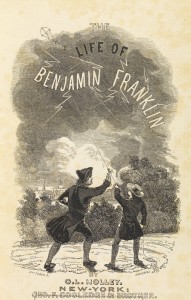Royal Society Puts 60 Historic Papers Online
/https://tf-cmsv2-smithsonianmag-media.s3.amazonaws.com/filer/201105201023101752SA.jpg)

The Royal Society, one of the world's oldest scientific societies, turns 350 next year, but the British institution is starting its birthday celebrations a little early. Today, the Society launches an interactive timeline, Trailblazing, which highlights its publishing history by making the original texts of 60 of its most significant papers available online.
Have you ever wanted to read Benjamin Franklin's own account of flying a kite in a rainstorm and discovering electricity? Now you can. (A Letter of Benjamin Franklin, Esq; to Mr. Peter Collinson, F. R. S. concerning an Electrical Kite)
Other highlights include:
- Isaac Newton's theory of light and color, from 1672
- A 1763 treatise on the use of willow bark to treat fever, which would lead to the development of aspirin
- One of Caroline Herschel's comet discoveries (she was the first paid female scientist)
- An 1826 paper on how the Earth's atmosphere changes with altitude
- Proof that fingerprints are unique
- Barbara McClintock's discovery of jumping genes
- James Watson and Francis Crick on the structure of DNA
- From 1965, the theory of continental drift
- Early writing on black holes by Stephen Hawking and Roger Penrose
There's enough in the timeline to keep me reading well into 2010, when the Society's celebrations pick up speed. I think I'll tackle Franklin's letter first, followed by Caroline Herschel's comet discovery. Which one will you read?
The Royal Society, one of the world's oldest scientific societies, turns 350 next year, but the British institution is starting its birthday celebrations a little early. Today, the Society launches an interactive timeline, Trailblazing, which highlights its publishing history by making the original texts of 60 of its most significant papers available online.
Have you ever wanted to read Benjamin Franklin's own account of flying a kite in a rainstorm and discovering electricity? Now you can. (A Letter of Benjamin Franklin, Esq; to Mr. Peter Collinson, F. R. S. concerning an Electrical Kite)
Other highlights include:
- Isaac Newton's theory of light and color, from 1672
- A 1763 treatise on the use of willow bark to treat fever, which would lead to the development of aspirin
- One of Caroline Herschel's comet discoveries (she was the first paid female scientist)
- An 1826 paper on how the Earth's atmosphere changes with altitude
- Proof that fingerprints are unique
- Barbara McClintock's discovery of jumping genes
- James Watson and Francis Crick on the structure of DNA
- From 1965, the theory of continental drift
- Early writing on black holes by Stephen Hawking and Roger Penrose
There's enough in the timeline to keep me reading well into 2010, when the Society's celebrations pick up speed. I think I'll tackle Franklin's letter first, followed by Caroline Herschel's comet discovery. Which one will you read?
/https://tf-cmsv2-smithsonianmag-media.s3.amazonaws.com/accounts/headshot/Sarah-Zielinski-240.jpg)
/https://tf-cmsv2-smithsonianmag-media.s3.amazonaws.com/accounts/headshot/Sarah-Zielinski-240.jpg)